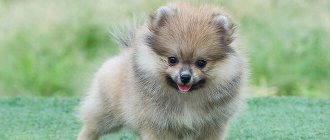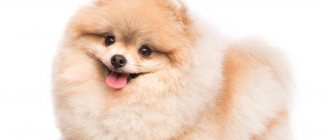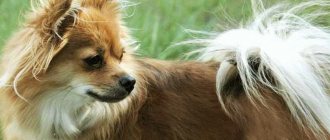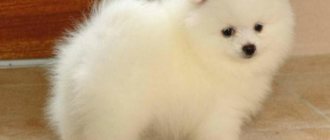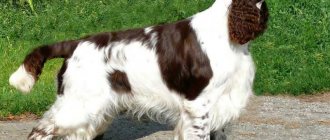Fox-type Pomeranians have a cute appearance.
Their exterior almost completely corresponds to the breed standard.
The best Fox-type Pomeranians are believed to be of American origin.
However, such dogs are also bred in Russian nurseries, although their popularity is inferior to the “bear” type Pomeranians.
Tendency to diseases
Spitz are dogs with good health. They are distinguished by their longevity. With good care they live up to 20 years. But even they can be plagued by diseases that you need to know about:
- diseases of the musculoskeletal system (necrosis of the femoral head, subluxation of joints, dislocation of the patella);
- complications during labor;
- bulging eyes characteristic of dwarf breeds;
- eye diseases (including cataracts, entropion, retinal dysplasia and atrophy);
- complications with teeth (especially during their change).
- inguinal and umbilical hernias;
- heart diseases;
- breathing problems, frequent coughing and sneezing.
Origin story
The toy-type Pomeranian is an artificially bred breed. To obtain the doll-type Spitz, the German breed was crossed with various toy dogs. This was done to reduce the size of the pet. As a result of selection, it was possible to obtain not only a dwarf appearance, but also to significantly improve the external characteristics of the animal:
- the fur has become more shiny;
- the characteristic fluffiness of the type has formed;
- dogs have become even more toy-like.
Breed description, standards and appearance
According to the ICF classification, the Pomeranian Spitz breed is the smallest subspecies of the German Spitz. AKC distinguishes it as a separate variety. Despite such controversies, the animals have characteristic features that make them easy to distinguish from other dogs.
The Pomeranian has a compact size and impressive appearance. He resembles an ordinary Spitz, only very miniature. The main pride is the thick and shiny fur, which forms a chic collar on the neck.
According to the FCI standard, a typical representative of the breed looks like this:
- The head is wedge-shaped, tapering towards the lobe, reminiscent of a fox.
- The muzzle is narrow, approximately half the length of the skull.
- The nose is small, the lobe is colored black or dark brown. Pomeranians with such a face are called “little foxes.”
- The jaws are closed in a scissor bite.
- The eyes are dark, oval, slightly slanted.
- The ears are triangular, located high on the head and next to each other.
- The neck is graceful, slightly curved, and there is no dewlap.
- The body is square in shape. The withers are clearly visible, the back and loin are as short and strong as possible. The chest is deep, the belly is tucked.
- The tail is set high and lies in a ring on the back.
- The limbs are located widely and parallel. The shoulders and thighs are muscular, the paws are compact and rounded.
Adult dog sizes:
- height at withers is 18-22 cm;
- The weight of a Spitz ranges from 1.4 to 3.2 kg.
A show Pomeranian should weigh about 2 kg. Specimens that are too large or small are unlikely to receive a high rating.
Pomeranians grow until they are 6-7 months old, after which they only gain weight due to muscle development. At 1.5 years old, Pomeranians weigh 300-500 g more than at six months.
Full formation is completed by 2 years. The average life expectancy is 15 years.
It is impossible to influence the size of the animal - both miniature and rather large puppies can be born in one litter. You can understand what an adult Pomeranian will be like only at six months of age. Therefore, to participate in exhibitions, it is better to buy fully grown juniors.
The presented Spitz weight table will help you choose a baby that meets the standard.
| Age, months | Weight, g | ||||||||
| Newborn | 70 | 80 | 90 | 100 | 120 | 130 | 145 | 160 | 170 |
| 1 | 200 | 235 | 275 | 320 | 370 | 460 | 540 | 600 | 655 |
| 2 | 320 | 375 | 460 | 550 | 615 | 680 | 830 | 945 | 1055 |
| 3 | 465 | 575 | 690 | 800 | 915 | 1030 | 1350 | 1395 | 1530 |
| 4 | 600 | 745 | 885 | 1025 | 1170 | 1305 | 1625 | 1765 | 1900 |
| 5 | 715 | 885 | 1030 | 1195 | 1370 | 1540 | 1880 | 2050 | 2200 |
| 6 | 770 | 975 | 1155 | 1305 | 1515 | 1715 | 2100 | 2280 | 2500 |
Color
Spitz hair is a characteristic feature of the breed. Thanks to the abundant undercoat, it bristles, making the dog even more fluffy. The orange can be completely black or black and tan, brown, cream, orange, white. The list of permitted colors includes the following suits:
- zonal gray;
- cream sable;
- orange-sable.
There are spotted individuals, but then the main color should be white, and the spots should be evenly distributed throughout the body.
Breed color
The palette of your pet's coat may surprise you. Twenty of its shades have been established. The extensive selection will satisfy anyone looking to have a furry friend. Fox dogs are most often:
- redheads;
- beige;
- blue;
- black;
- brown;
- sable color;
- creamy.
If you want to take part in the exhibition, you need to know that white spots in the pet’s color are not standard and are considered a defect. White and beige colors are a pleasant exception. But no matter what color the pet is, it is always cheerful and active.
Large (wolf)
The name Keeshond is also used. The largest type of the German ones. They are distinguished by a strong build. Males are 42 - 47 cm tall and weigh about 20 kilograms, females are 40 - 45 cm and weigh 16 kilograms. The color is very similar to a wolf, zonal gray with a black mask on the muzzle. The ears and tip of the tail should also be black. They are used as herding dogs and guard dogs . Aggressive and distrustful of strangers. The average lifespan is 16 - 17 years.
Description of breed standards
The "toy" Spitz is an intermediate type between the "bear" and "fox" types. At first glance, it is not immediately clear whether this is a real dog or a toy.
Toy Pomeranian Spitz
It is quite difficult to distinguish a “toy” from a “teddy bear”. The differences are in a flatter muzzle and higher-set, slightly spaced eyes. Otherwise, they are quite similar in terms of the following characteristics:
- body: the height and length of the body are proportional 1 to 1;
- head: narrowed occiput, not clearly defined transition;
- nose: black, oval shape;
- muzzle: slightly elongated, proportions 2 to 4;
- mouth: black, upper and lower lips fit tightly, no folds in the corners;
- jaws: 42 teeth, pincer and scissor bites are allowed;
- cheeks: round, not protruding;
- eyes: slightly slanted, oval-shaped, small in size and black in color;
- ears: set high, sticking out in a triangle, close to each other;
- neck: short, covered with a thick and lush layer of fur;
- ponytail: medium length, high-set, rounded to the body;
- fur: very dense, does not curl or become shaggy;
- color: white;
- weight: males - 3 kg, females - 2.5 kg;
- height: up to 22 cm.
The lifespan of these dogs ranges from 12 to 15 years.
A puppy of this breed should not have any impurity in color; according to the standard, only slight yellowness on the ears is allowed. This species is quite rare and expensive.
Spitz breed varieties
Spitz dogs are a large group of animals. All representatives of the breed have similar features: a narrow muzzle, pointed ears, fluffy fur and a curled tail. However, they differ in size and color, so they are divided into separate types.
The Pomeranian is probably the most beautiful and charming of all Spitz breeds. For this he was even given the nickname “Royal Spitz”. Thick fur with dense undercoat is a distinctive feature of animals. A smooth-haired dog will be out of breed.
Important. If you regularly cut off the luxurious fur at the root, the Pomeranian runs the risk of remaining short-haired forever.
The following types of Pomeranian Spitz are distinguished:
- Fox - distinguished by a narrow and elongated muzzle, which is very similar to a fox, well-furred cheeks, and pointed ears. The Pomeranian fox has a lighter bone structure, and its tail is longer than that of the “bear cub”.
- Teddy bear – has a flattened, wide muzzle. The chin is slightly raised, the tip of the nose is raised.
- Baby doll – the muzzle is quite wide, the rise is higher than that of “foxes”, but less than that of “bear cubs”.
Only the Fox-type Pomeranian meets the breed standard.
The Pomeranian belongs to a large group of breeds called Spitz-type dogs. They come in different sizes - large ones play the role of watchmen and shepherds, small ones have received a well-deserved reputation as decorative pets. The German Spitz breed standard includes the following types of Spitz:
- Wolfspitz (Keeshond) is the largest Spitz. Height ranges from 43 to 55 cm. It is distinguished by its characteristic wolf color.
- Grossspitz (large spitz) – grows up to 42–50 cm, can be black, chocolate or white.
- The Mittelspitz (medium Spitz) is a typical representative of the fox type. Height – 32–38 cm. The average Spitz has the same colors as Pomeranians.
- Kleinspitz (small Spitz) - 23–29 cm high. The range of shades is represented by black, brown, white and other colors.
Other species of the Spitz family:
- Japanese Spitz - combines the beautiful color of the Samoyed and the miniature size of the Pomeranian. Height is about 40 cm, weight is about 10 kg. Due to its similarity to the American Eskimo Dog, it is not recognized by the AKC.
- The American Eskimo Spitz, or Eskie, is a rare representative of the Spitz-like species. Wool can only be white or milky; other colors are discarded.
- The Eurasian Spitz is a cross between the German Wolfspitz and the Chow Chow. Grows up to 60 cm in height, weight does not exceed 30 kg.
- The Italian Spitz Volpino is a small dog with a height of 25–30 cm, originally from Italy. Allowed colors are snow-white, red or fawn. Volpino is a very rare breed that has been on the verge of extinction for a long time.
Due to their external similarity, sled dogs and hunting dogs are often classified as varieties of the Spitz dog breed:
- Greenland dog;
- Karelian-Finnish Laika (Finnish Spitz);
- Karelian Bear Dog or Karelian Bear Laika.
According to the RKF classification, they all belong to the same group, since they have common ancestors.
These are the most common types of Spitz. There are no such breeds as Irish or Russian Spitz. Unscrupulous owners sometimes try to pass off mixed-breed dogs as new varieties of Spitz.
A little history
These dogs were first seen in Germany in Pomerania. The Pomeranian is the smallest of the Spitz breeds. The first migration of these dogs occurred in 1870 to Great Britain during the reign of Queen Victoria.
In 1871, Her Majesty founded the Pomeranian Spitz Club, which began to establish the first breed standards. They specified that Pomeranians are a dwarf subspecies.
But after 1945, the German Spitz club revised the breed standards. Today, the most exemplary Pomeranians come from America.
Character and education
A description of a breed will be incomplete without an understanding of its character. Like other small dogs, he is quite short-tempered. The kid considers himself a formidable defender and is ready to fight an enemy larger than him.
In addition to reckless courage, the Spitz dog breed is distinguished by boundless devotion. Animals sincerely love all family members and suffer greatly if they are left alone for a long time. A cheerful pet never refuses games and walks.
Pomeranians are highly intelligent, but you need to find an approach to them. Representatives of the breed are stubborn and prone to dominance, so they should be trained by an experienced dog breeder.
The training and socialization of the puppy begins immediately after it adapts to the new place. The pet is taught:
- respond to name;
- relieve yourself on the street;
- follow the rules of cohabitation.
A little later, they begin to master the basic set of commands:
- at 2 months – “You can’t”, “Fu”, “Come to me”, “Sit”;
- at 3 months – “Lie down”;
- at 4 months – “Stand”;
- at 5-6 months - “You can”, “Wait”, “Walk”.
You can teach your Pomeranian various tricks - to speak on command, sit on its hind legs, etc. However, it is important not to overload your pet - classes should be short and varied.
Spitz and children
Pomeranians are great with children. It is better to trust your pet to teenagers who already know how to handle animals and understand their body language.
A small child will perceive the pet as a toy, which is dangerous for the fragile Pomeranian. The baby may accidentally injure the dog, and he will be forced to defend himself.
Preparatory work
Before bringing a puppy into your home, you should take the necessary steps. First you need to hide:
You should also block access to dangerous crevices and place your shoes higher. Otherwise, everything will be tested for taste and fun.
Definitely worth it:
- Determine a resting place for the puppy. This can be a corner without drafts and heating devices. Specialized stores sell various baskets and houses for small dogs such as the Spitz fox.
- It is also necessary to designate a place for the pet to eat and quench its thirst. For this he must have special bowls.
- At the initial stage, you will need disposable diapers. The puppy cannot be taken outside yet, but he must relieve his natural needs and he will do this in the apartment.
- You should purchase a tray. If your future plans are to train your Pomeranian to a litter tray, it should be in a certain place.
- Buy toys. They are necessary for play and so that the puppy can chew on them.
Keeping a fox-type Spitz in the house is not a very difficult task, but it cannot be called simple either. The animal is unpretentious in care, nutrition, and living conditions. But the character and molting of the pet will require time, patience, effort and finances from the owner.
How to choose a Pomeranian puppy
The optimal age for weaning is 2 months. At this time, the puppy is already ready for independent life. There is no point in picking up your baby earlier. He is still undergoing initial socialization, learning to behave in a pack and communicate with others.
Criterias of choice
Spitz puppies born in the same litter are always different: some have an excellent exterior, others have deviations from the standard. A self-respecting breeder will definitely point out the characteristics of each baby and tell you which one is better to choose.
On a note. The bear cub is more expensive than the fox because it is in higher demand.
Show class
These are the most expensive dogs, having a first-class anatomical structure and temperament. They are born from champion parents who consistently take high places at various exhibitions. The cost of show-class oranges is 50-100 thousand rubles.
Breeding class
For people planning to engage in breeding, breed-class Spitz puppies are suitable. They have a good pedigree, but have some disadvantages, so they are less likely to be successful in shows. However, with the right choice of partners, such individuals produce outstanding offspring. Average prices range from 30 to 50 thousand rubles.
On a note. A breeding class girl costs more than a boy.
Pet class
Such puppies show significant deviations from the standard, but these are by no means mixed breeds. Due to severe defects, they cannot take part either in exhibitions or in breeding work. However, pet-class animals make excellent pets. The cost is about 15 thousand rubles.
What to pay attention to
Before choosing a Spitz, you need to study all the information: the characteristics of the breed, its advantages and disadvantages, the nuances of maintenance and care. It is advisable to communicate with the current owners and, if possible, visit exhibitions.
The gender of the pet is also important. The Pomeranian Spitz boy has a “cool” temperament - he is cocky, willful, persistent and stubborn. Training will require patience and firmness. However, at exhibitions, males look more advantageous.
The Pomeranian Spitz girl is usually affectionate, flexible and calm. She is easier to raise, but she will also require more attention. Estrus, pregnancy, childbirth and caring for puppies will bring additional troubles.
When choosing a boy or girl, you need to objectively assess your strengths. If there is not enough experience in training or there is a desire to become a breeder, it is better to choose a female. Males are suitable for experienced dog breeders.
To choose the right Spitz puppy, you should carefully examine it for breed characteristics and defects. Felted fur, inflammation on the skin, pus in the eyes, an unpleasant odor, and a bloated stomach indicate health problems.
Education and training
Training Spitz dogs is not an easy task due to their “primitive” roots. Start working as early as possible in order to stop their natural stubbornness in puppyhood and prevent the development of aggressiveness and harmfulness. Take advantage of their strong instinct to follow the leader, prove that you are in charge - it will become easier to train the Spitz, and he will take your severity and fairness for granted. And even in this case, you risk becoming a victim of his fox cunning: he will never give up trying to command you.
How to diaper a Pomeranian
- place special diapers in places where the animal relieved itself (there can be quite a lot of them),
- you can place a rag soaked in puppy urine on it,
- after a few weeks, reduce the number of diapers,
- wipe and sanitize the floor where the puppy left a puddle,
- After another week, leave only one place where you will place “toilet” diapers.
Pomeranian Spitz: how to toilet train
Accustom your puppy to the tray, as well as to diapers, from an early age. Don't buy multiple trays to place in each room. To scare your pet away from undesirable places to relieve itself, use an antigas spray. Do not keep the puppy in the litter box for too long; it is better to take him there more often.
Basic Commands
Five-month-old puppies are already quite capable of performing all basic commands:
- approach: in hard (“Come to me!”) and soft (“Come here” or nickname) versions;
- movement nearby: to the command “Near!” the dog runs at the owner’s feet, does not run ahead, does not lag behind, does not throw himself at the feet and does not pull to the side; a team is necessary for exhibitions and comfortable, safe walks;
- taking the desired pose: the command “Sit!” useful in public transport, “Stop!” — at exhibitions, if the animal is trained in the exhibition stand; the dog must know the “release” signal (for example, a slap on the rump or “Walk!”), upon which it stops following the command;
- excerpts: for discipline during feedings and building hierarchy in the family.
Properly trained Spitz dogs look better and perform better in the ring; there is no shame in bringing them out into the public eye.
Price
In the cabin
Salon grooming is a whole range of procedures, not just a haircut. Includes:
- combing;
- bathing;
- drying;
- a haircut;
- cleaning ears, eyes;
- trimming nails.
The prices for the procedure are quite high. In a professional establishment they start from 2,000 rubles. (in Moscow).
Before and after grooming
At home
To save money, you can call a groomer to your home after brushing and bathing yourself. Then a haircut will cost from 1,000 rubles.
You can also perform a regular hygienic haircut yourself for free. It’s not worth the risk of styling it as a fox cub yourself, so as not to harm the dog.
Advantages and disadvantages
Among the most obvious positive aspects are:
- cheerfulness;
- intelligence;
- security deposits;
- loyalty and friendliness;
- love for children.
The dog has a very loud and ringing bark
. Disadvantages include:
- loud and restless barking;
- cockiness, attempts to dominate;
- manipulation;
- suspicious of strangers.
Care and maintenance
The Pomeranian Spitz dog breed is quite unpretentious. Even an inexperienced dog breeder can handle caring for her. A pet can live both in a spacious house and in a small apartment - it can easily adapt to any conditions.
The right diet
Pomeranians can be fed commercial food or natural food. When choosing ready-made food, it is necessary to study the composition of dry food. They must contain at least 40% meat, vegetables, grains, and a complex of vitamins and minerals. Premium and superpremium or holistic products meet these requirements.
When feeding a Spitz dog naturally, the following is given:
- lean meats and offal;
- sea fish;
- porridge – rice, buckwheat, oatmeal;
- dairy products;
- fresh herbs, vegetables and fruits.
Pets are fed strictly according to schedule. Pomeranians are prone to obesity, so you should not give food in excess of the norm. Fat animals are susceptible to heart and joint disease, diabetes and cancer.
Grooming and hygiene
The luxurious coat is combed with a wide-tooth comb at least twice a week; during seasonal shedding, the procedure is carried out daily. It is important to prevent the formation of tangles, otherwise the matted fur will have to be cut off. Pomeranians are bathed no more than 2 times a month so as not to disturb the natural hair structure.
For hygienic purposes, the hair on the ears, between the toes and around the anus is shortened. You can contact a groomer who will offer many options for stylish hairstyles.
The eyes and ears are examined regularly and discharge is removed if necessary. The claws are trimmed with pliers. Teeth are brushed 2-3 times a week with veterinary paste and a special brush. An alternative is dental treats.
Walking and physical activity
The Pomeranian Spitz dog breed is very active - walks in the fresh air are vital for it. A mobile pet can be let off a leash only in places where there are no cars or other dogs. Otherwise, the fearless dog will find problems for both himself and his owner. If it is very cold outside in winter, it is better to wear warm overalls for your pet.
Vaccinations and susceptibility to disease
The first vaccinations for puppies are given at 8-10 weeks, when the immunity transmitted through mother's milk weakens.
Animals are protected from:
- carnivore plague;
- parvovirus enteritis;
- adenoviral hepatitis;
- rhinotracheitis;
- leptospirosis;
- rabies.
Your Spitz puppy may respond to the vaccine by being lethargic or having a slight fever. Symptoms usually go away within 2-3 days. Adult animals are vaccinated annually and treated against fleas and blood-sucking parasites every 3 months.
Most diseases are associated with the small size of oranges. They have weak ligaments and joints, which can cause dislocations of the kneecap or bone displacements, even fractures. Problems with the eyes and teeth also often occur.
Other characteristic diseases:
- hypothyroidism;
- epilepsy;
- dysbacteriosis;
- spasms of the cartilaginous part of the larynx;
- colitis and gastritis.
Recently, Pomeranians began to suffer from hypoglycemia and congenital dwarfism.
Puberty
The period of puberty in Pomeranians begins at 6 months. At this time, males begin to become interested in females, and girls begin their first heat. However, the animals are not yet ready for mating. Their body is not sufficiently developed, so they are not able to bear full-fledged offspring. The optimal age for mating is 1.5-2 years.
What to feed
The Spitz fox is not picky about food. You can give him either dry food purchased at the nearest pet store or prepare it for your pet at home. The diet should be varied:
- lean raw or scalded meat;
- boiled liver, lungs, kidneys;
- eggs, both raw and boiled;
- thoroughly deboned boiled fish;
- kefir, fermented baked milk, cottage cheese;
- fruits, vegetables, herbs;
- wheat, buckwheat, oatmeal.
You cannot offer your dog: bones, salty foods, sausages, fried, smoked, spicy and confectionery products.
Useful tips
Your child will find it interesting and useful to spend time with the dog and develop a sense of responsibility. When purchasing, consider your lifestyle; some breeds require attention. You will have to spend a lot of time combing the fur. Often these dogs have lung and heart diseases. Therefore, be prepared to visit veterinary clinics.
You shouldn't wash your Spitz often. Otherwise, their fur will no longer be so soft and fluffy.
Spitz dogs are very attached to their owner, and if you suddenly start devoting more time to someone else, they may become offended and jealous. These dogs are sensitive and wary of strangers.
In general, these dogs are very cheerful and cheerful, they know how to cheer up. But be prepared that you will have to constantly comb and wash them. Their thick fur often mats and makes them uncomfortable. Almost all representatives of this breed are suitable for city apartments.
Due to the fact that these dogs are selectively bred, they often have allergies and other diseases, so you need to be careful about the health of your Spitz. The food must be of high quality. And after buying a puppy, you can’t change the diet for about a month. In the future, it is better to buy premium dry hypoallergenic food designed specifically for this breed.
Carefully study the composition of the food, it should contain a lot of protein. Sometimes it is useful to pamper your dog with sea fish, which is rich in phosphorus and calcium. Raw eggs and greens are no less useful. Always make sure their bowl is full.
Puberty and mating
For this breed of dog, a special breeding regulation has been developed, which stipulates the permitted age for mating - from 12 to 15 months.
You can start mating at one year of age
Note! According to veterinarians, puberty does not occur in dogs of this breed from the first heat. It is best to bring pets only on their third heat.
You can determine actual sexual maturity yourself:
- outwardly it is an adult animal;
- height and weight correspond to the breed standard;
- Bitches have a regular cycle.
Before breeding, make sure both pets are completely healthy. It would be ideal to conduct a veterinary examination of both the male and the female before the procedure.
When choosing a dog for breeding, consider:
- pedigree;
- presence of birth diseases;
- relationship between a bitch and a dog;
- presence of deviations from standards;
- quality of descendants, if any.
Pros and cons of the breed
Before you buy a Pomeranian puppy, you should consider its pros and cons.
But despite its abilities and advantages, the Pomeranian Spitz breed still has disadvantages. Parenting will require some experience and skills. On the street, males like to sort things out, picking on larger relatives. To prevent your pet from getting into mischief at home, you need to take him for a lot of walks, so couch potatoes should not get a Spitz dog.
All the pros and cons of the Pomeranian are presented in the table.
| Advantages | Flaws |
| Compact dimensions | Tendency to dominate |
| Charming appearance | Barking for no reason |
| Developed intelligence | High activity |
| Devotion | cockiness |
| Lack of hunting instinct | Waywardness |
| Good attitude towards children and other pets | Specific coat care |
Pomeranians are the cutest decorative dogs that become excellent companions for active people: in the morning little paws will stomp around the house, and in the evenings there will be a loud bark when the dog greets family members returning from work. These brave and energetic pets will remain faithful to their owner throughout their lives.
Dog character
The Spitz fox loves to play. This dog’s “smile” melts hearts. The animal is very obedient, always tries to please its owner and catches his every word. Adapts perfectly to the owner's schedule and will wake up and go to bed with him.
The dog will only support the active lifestyle of the owner. Long walks, jogging, traveling, hiking - the furry pet likes everything. But rest and household chores will also not go unnoticed by the Spitz.
The dog's intellectual abilities are at their best. She quickly finds contact with a person, thanks to her lively mind and resourcefulness. She instantly understands what is required of her, clearly following commands and even tricks.
The Spitz fox is a guard by nature. The size, of course, is not suitable for such an honorable service, but the dog will boldly defend its territory and will zealously begin to quarrel with representatives of larger breeds, raising a ringing bark.
Special attention should be paid to the disadvantages of this breed:
- When the seasonal shedding begins, Spitz dogs lose a lot of hair, and it will be everywhere. Dogs should be brushed regularly.
- Increased dominance in the temperament of a fox entails a lot of problems. She will conflict with any animal.
- This breed of animal is very “barking”. Loud barking can annoy neighbors.
But if you conscientiously take care of and raise your pet, then everything can be adjusted.
Dog grooming
Pomeranian Spitz puppies at a young age are very similar to bear cubs. As babies begin to grow up, their appearance changes. But often owners want their dogs to continue to look like the bear type.
You can do without destructive selection and just go to a grooming salon. Especially if your pet has round eyes. The specialists of such salons cut the coat in such a way that the dog looks as much like a teddy bear as possible.
First of all, hairdressers cut the top layer of the coat, as a result of which the length of the undercoat is compared with the length of the rest of the coat. After this, the masters trim the hair on the head, giving it the required shape. If the work is done well, then even the not very suitable eyes become visually rounder.
But there are also rules here: you cannot cut the inner layer of the coat, since it cannot be restored. Accordingly, cutting with a clipper, especially bald, is strictly prohibited. If the groomer makes a mistake, your Pomeranian will remain shorthaired forever.
Differences and similarities with bearish
Based on the appearance of a newborn puppy, it is difficult to determine what type of breed it belongs to. Differences appear at the age of 8 - 10 months.
At exhibitions and among breeders, the fox type is recognized as the standard one, but preference among mini dog lovers goes to the bear type. "Chanterelles" are more graceful and elegant. Their fur is not as thick as that of bear cubs, so they look slimmer. The pointed and slightly elongated muzzle resembles a fox.
The bear type of Pomeranian Spitz is the spitting image of a bear cub with a round muzzle, round eyes and thick paws due to thick fur.
Small German Spitz
The Small German or Kleinspitz is one of the varieties of its group . His height should be 23-29 cm , weight is not strictly estimated, usually it is 3-6 kg . The dog's appearance fully meets all the requirements for Spitz dogs. The difference is in the ratio of the length of the muzzle to the size of the skull ( 2:4 ) and the number of teeth (the absence of some premolars is acceptable).
Acceptable colors for the variety: white, orange, black, brown, wolf. The latter is also called “gray with black”. It consists of silver hair with black tips, a dark zone on the face and ears, a light zone on the mane, shoulders, edge of the tail and pants. Also characteristic is a dark rim around the eyes.
Pure cream and white colors, sable with red or cream tint, black and tan and spotted are also acceptable. In the latter case, on a white background there are spots of a different tone, evenly distributed throughout the body.
German Spitz are pets with a funny appearance and balanced character. With proper upbringing, they become ideal friends for the whole family, but you should not treat them like a toy and spoil them too much.

